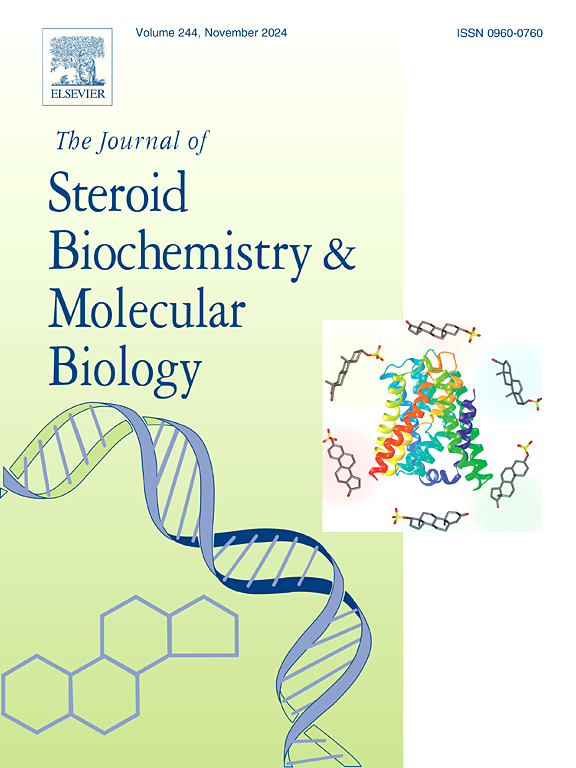Phytoestrogens as potential anti-osteoporosis nutraceuticals: Major sources and mechanism(s) of action
IF 2.5
2区 生物学
Q3 BIOCHEMISTRY & MOLECULAR BIOLOGY
Journal of Steroid Biochemistry and Molecular Biology
Pub Date : 2025-03-24
DOI:10.1016/j.jsbmb.2025.106740
引用次数: 0
Abstract
By 2050, the global aging population is predicted to reach 1.5 billion, highlighting the need to enhance the quality of life of the elderly population. Osteoporotic fractures are projected to affect one in three women and one in five men over age 50. Initial treatments for osteoporosis in postmenopausal women include antiresorptive agents such as bisphosphonates, strontium ranelate, estrogen replacement therapy (ERT) and selective estrogen receptor modulators (SERMs). However, these do not rebuild bone, limiting their effectiveness. Denosumab, an FDA-approved antiresorptive monoclonal antibody, also has drawbacks including high costs, biannual subcutaneous injections, slow healing, impaired bone growth and side effects like eczema, flatulence, cellulitis, osteonecrosis of the jaw (ONJ) and an increased risk of spinal fractures after discontinuation of treatment. Nutraceuticals, particularly phytoestrogens, are gaining attention for their health benefits and safety in osteoporosis prevention, management and treatment. Phytoestrogens are plant metabolites similar to mammalian estrogens and include isoflavones, coumestans, lignans, stilbenes, and flavonoids. They interact with estrogen receptor isoforms ERα and ERβ, acting as agonists or antagonists based on concentration and bioavailability. Their tissue-selective activities are particularly significant: anti-estrogenic effects in reproductive tissues may lower the risk of hormone-related cancers (such as ovarian, uterine, breast and prostate), while estrogenic effects on bone could contribute to the preservation of bone mineral density.Phytoestrogens are, thus, used in managing breast and prostate cancers, cardiovascular diseases, menopause and osteoporosis. The present review focuses on the botanical origin, classification, sources and mechanism(s) of action of major phytoestrogens, their potential in prevention and management of osteoporosis and the requirement for additional clinical trials to achieve more definitive outcomes in order to confirm their efficacy and dosage safety.
植物雌激素作为潜在的抗骨质疏松营养品:主要来源和作用机制。
到2050年,全球老龄化人口预计将达到15亿,这凸显了提高老年人生活质量的必要性。骨质疏松性骨折预计会影响50岁以上三分之一的女性和五分之一的男性。绝经后妇女骨质疏松症的初始治疗包括抗吸收药物,如双膦酸盐、雷奈酸锶、雌激素替代疗法(ERT)和选择性雌激素受体调节剂(SERMs)。然而,这些不能重建骨骼,限制了它们的有效性。作为fda批准的抗再吸收单克隆抗体,Denosumab也有一些缺点,包括成本高,一年两次皮下注射,愈合缓慢,骨骼生长受损,副作用如湿疹,胀气,蜂窝组织炎,颌骨骨坏死(ONJ),以及停止治疗后脊柱骨折的风险增加。营养品,特别是植物雌激素,因其在预防骨质疏松症方面的健康益处和安全性而受到越来越多的关注。植物雌激素是一种类似于哺乳动物雌激素的植物代谢物,包括异黄酮、coumestans、木脂素、stilbenes和类黄酮。它们与雌激素受体同种异构体ERα和ERβ相互作用,根据浓度和生物利用度作为激动剂或拮抗剂。它们的组织选择性作用尤其显著:生殖组织中的抗雌激素作用可能降低激素相关癌症(如卵巢癌、子宫癌、乳腺癌和前列腺癌)的风险,而雌激素对骨骼的作用可能有助于保持骨密度。因此,植物雌激素被用于治疗乳腺癌和前列腺癌、心血管疾病、更年期和骨质疏松症。本文综述了主要植物雌激素的植物来源、分类、来源和作用机制,它们在预防和治疗骨质疏松症方面的潜力,以及需要进行更多的临床试验以获得更明确的结果,以确认它们的有效性和剂量安全性。
本文章由计算机程序翻译,如有差异,请以英文原文为准。
求助全文
约1分钟内获得全文
求助全文
来源期刊
CiteScore
8.60
自引率
2.40%
发文量
113
审稿时长
46 days
期刊介绍:
The Journal of Steroid Biochemistry and Molecular Biology is devoted to new experimental and theoretical developments in areas related to steroids including vitamin D, lipids and their metabolomics. The Journal publishes a variety of contributions, including original articles, general and focused reviews, and rapid communications (brief articles of particular interest and clear novelty). Selected cutting-edge topics will be addressed in Special Issues managed by Guest Editors. Special Issues will contain both commissioned reviews and original research papers to provide comprehensive coverage of specific topics, and all submissions will undergo rigorous peer-review prior to publication.

 求助内容:
求助内容: 应助结果提醒方式:
应助结果提醒方式:


